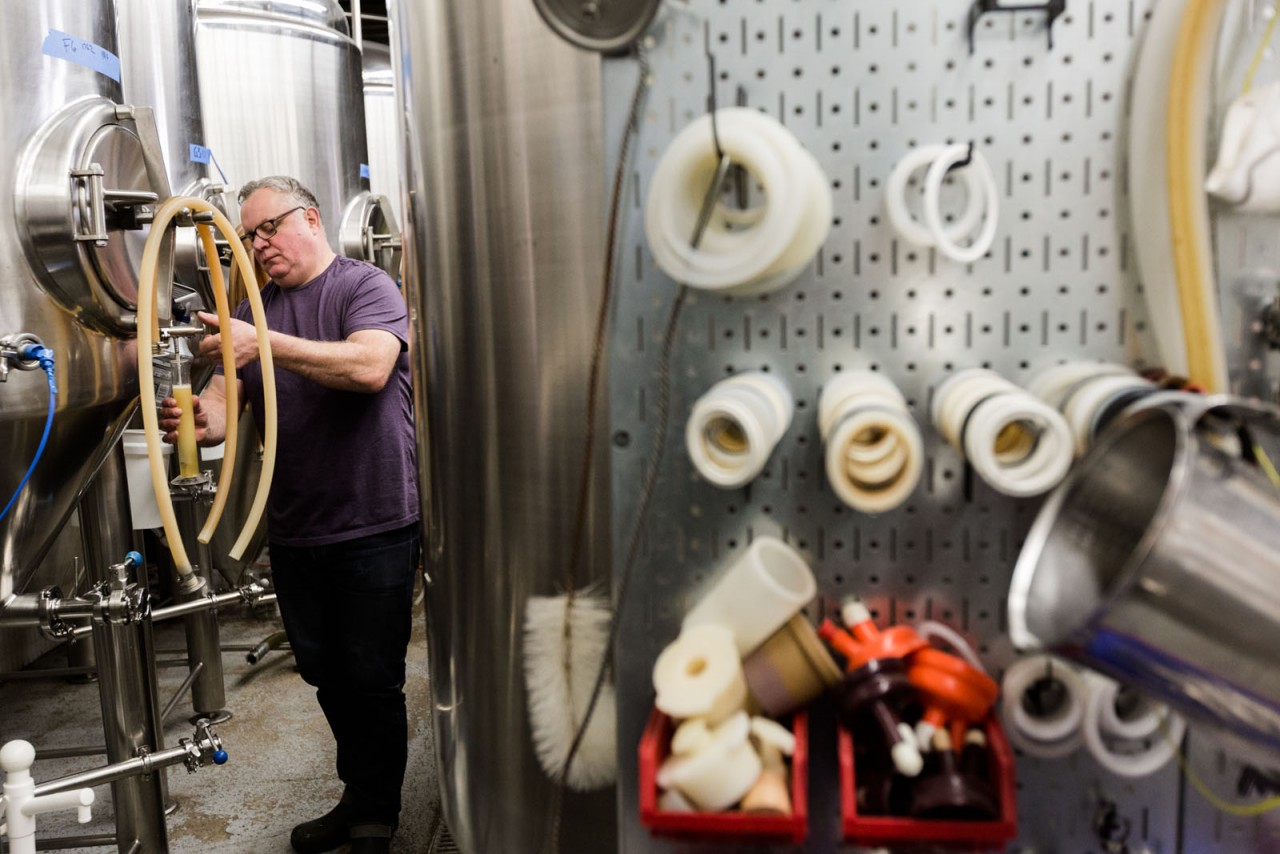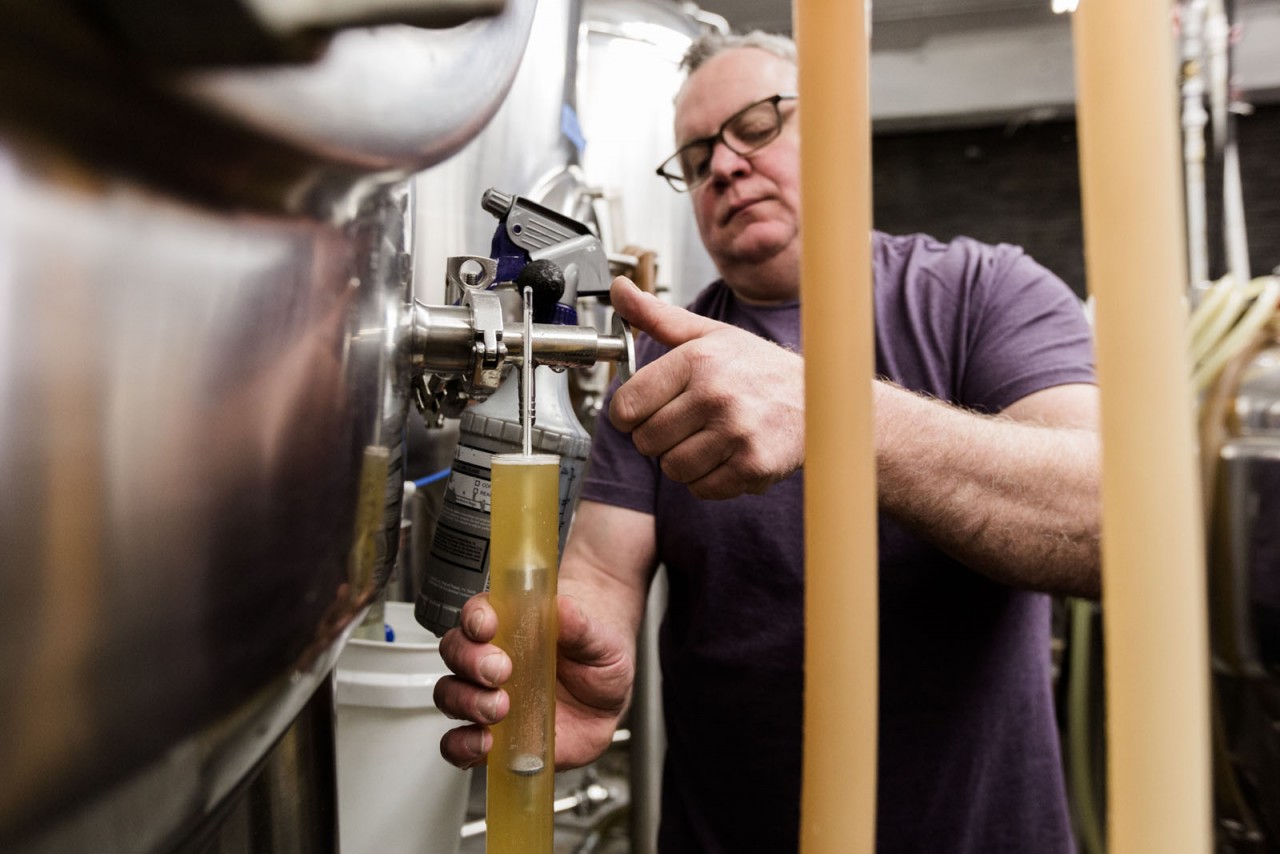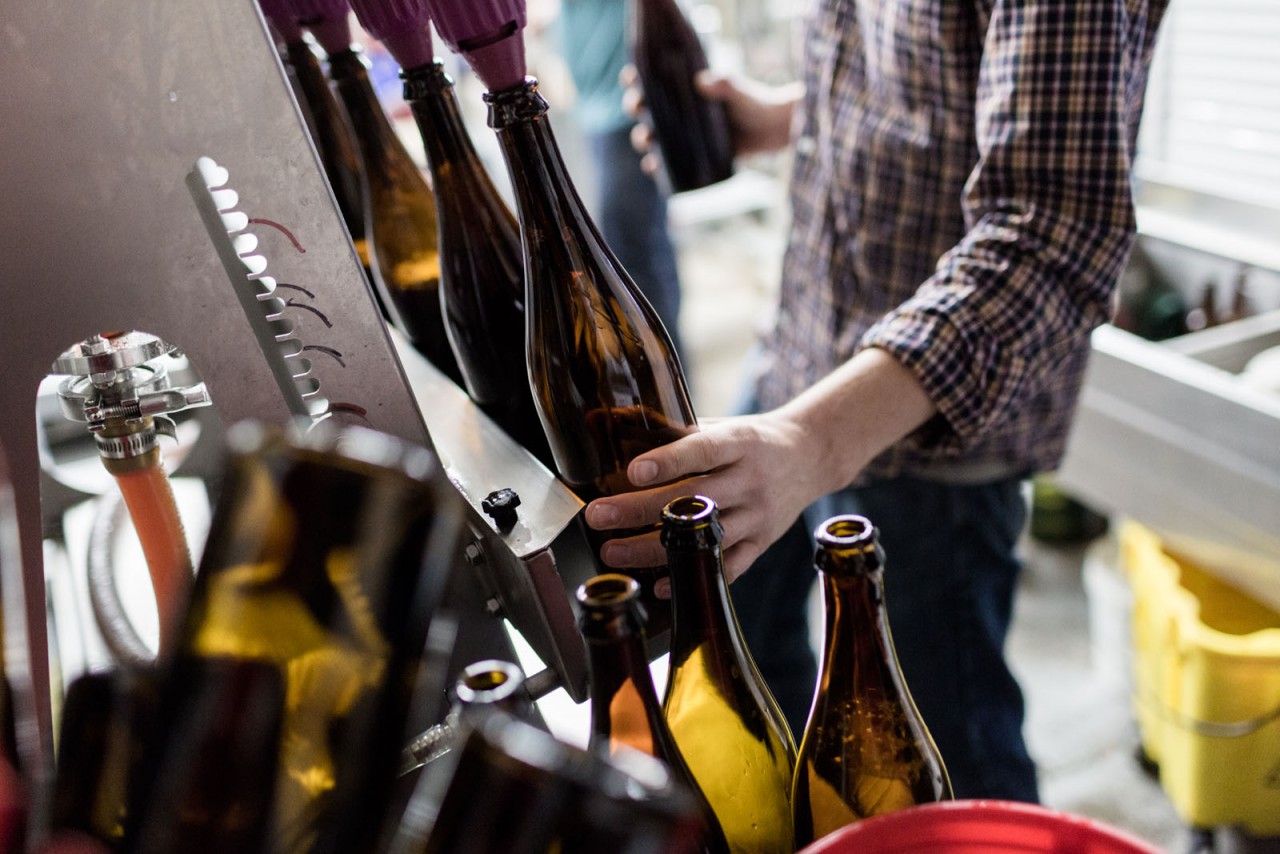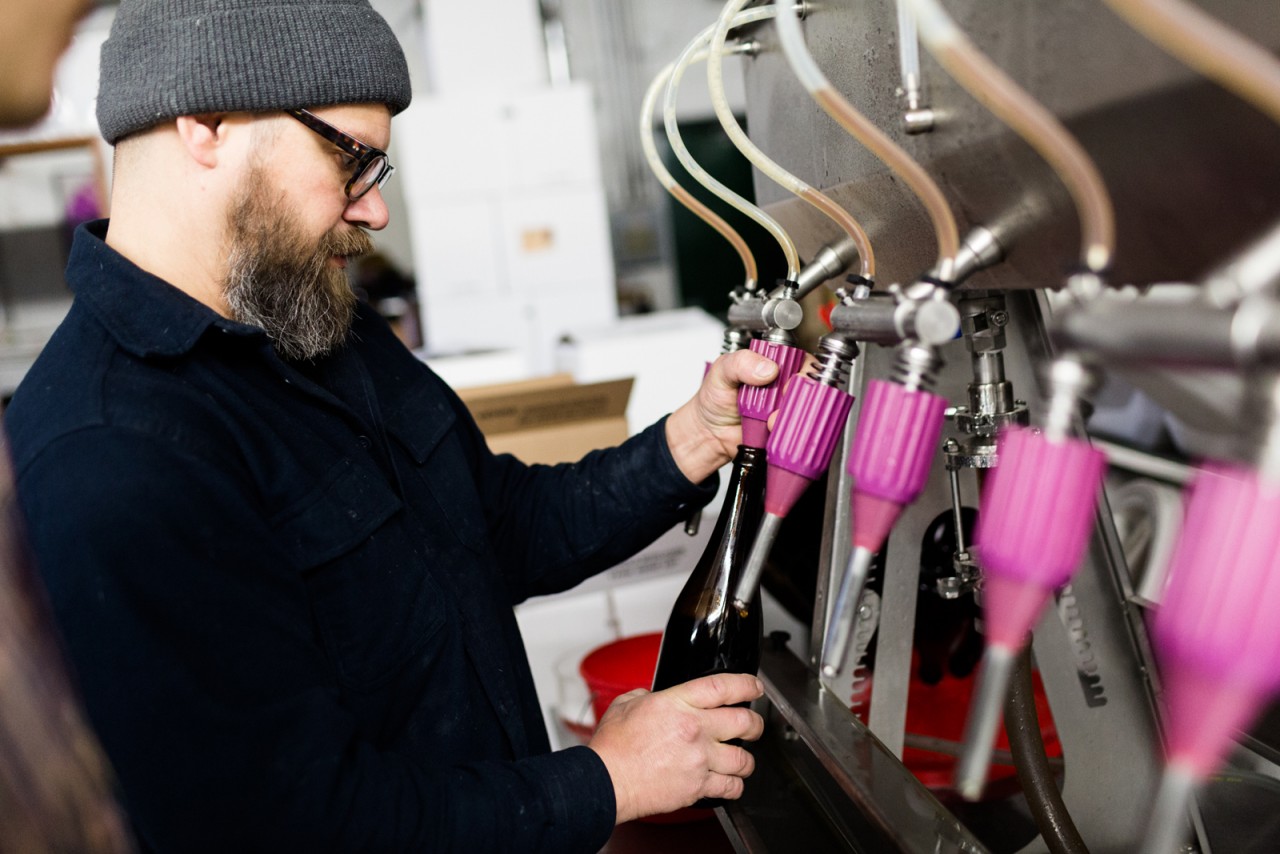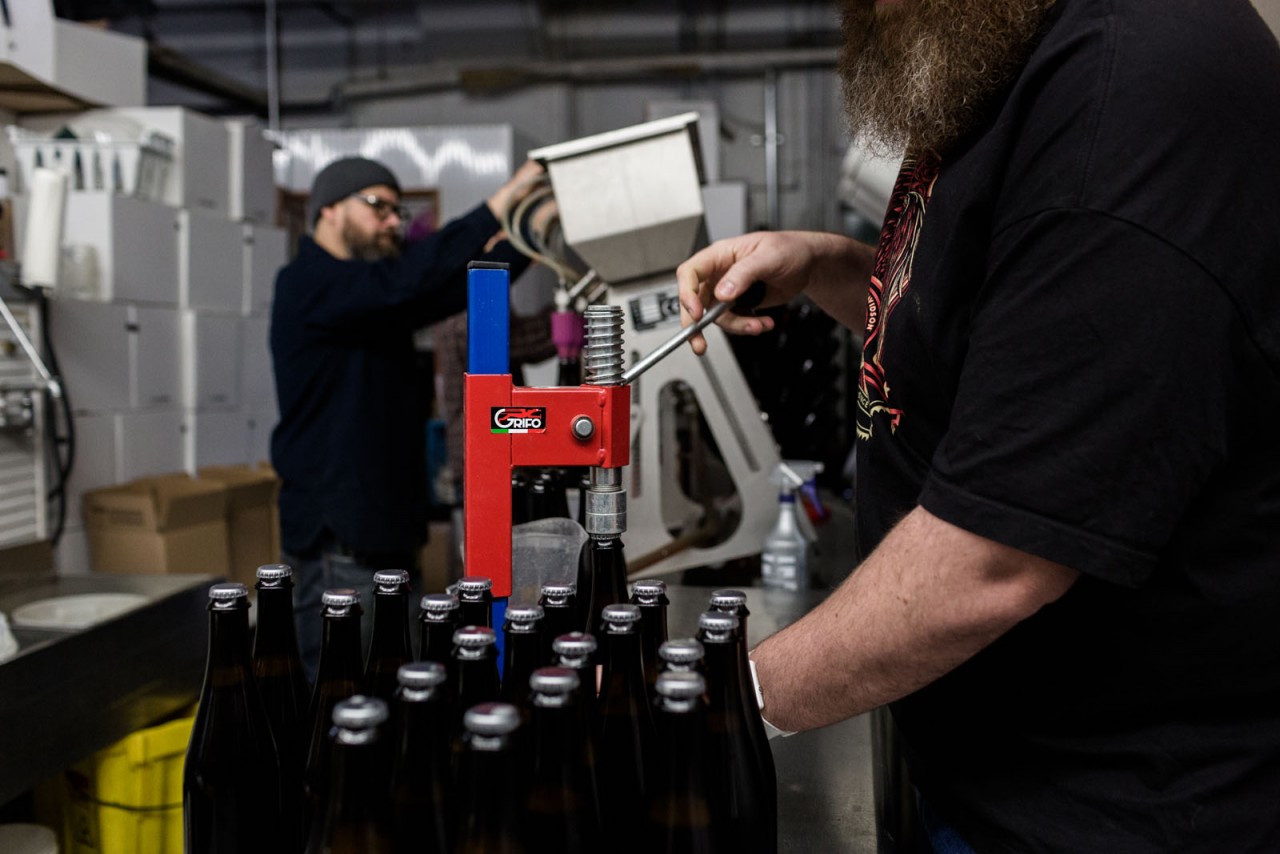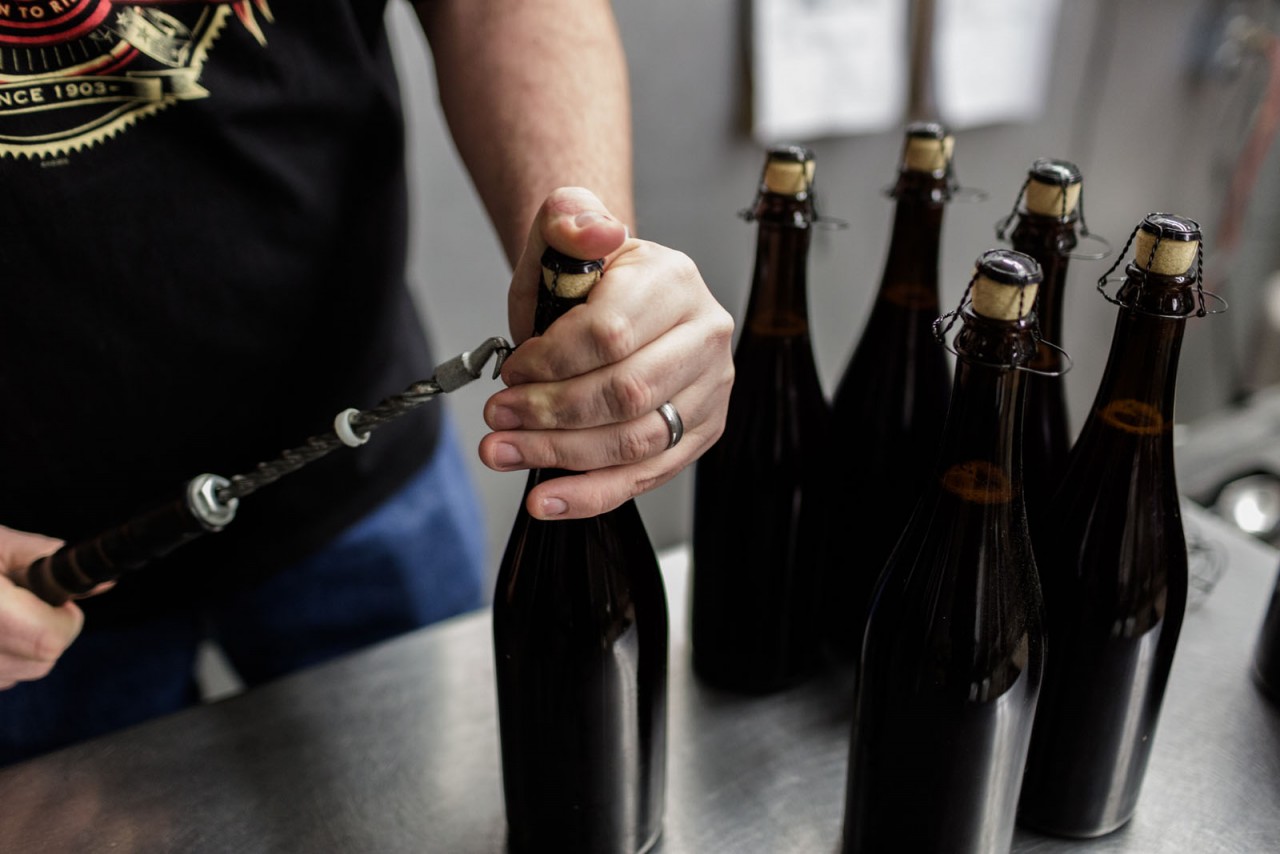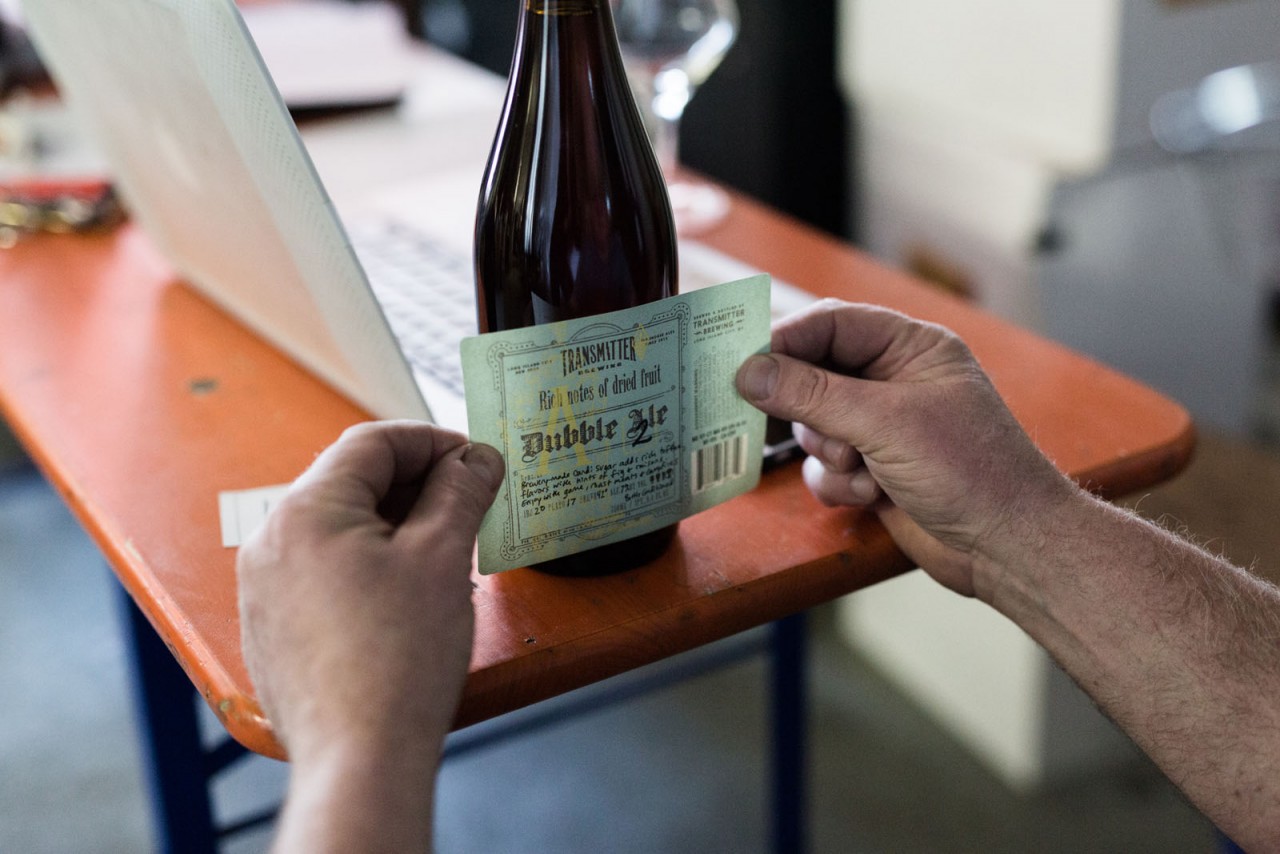Transmitter Brewing
Posted March 28, 2016
Interview by Andrew Chen
Photos by Minnow Park
The first thing you’ll notice when walking into Transmitter Brewing is the smell: it’s an intoxicating mix of sweet, ripe fruits and fresh baked bread. If you’re lucky, they’ll also be boiling some sugar down in the corner to make their own Belgian candi sugar – this, too, smells delicious. And if you’re really lucky (like us) you’ll get to try some straight out of the pot.
On the day we visited, Transmitter was cooking down sugar to make a lime syrup for NY4, a special one-off Berliner Weisse beer made of all NY ingredients specifically for NYC Beer Week. NY4 ended up taking home the “Best SMaSH Beer” award (the SMaSH acronym refers to beers that only use State Malts and State Hops). Transmitter also won the 2016 Ruppert’s Cup awarded to NYC’s favorite Craft Brewer.
Transmitter co-founders Rob Kolb and Anthony Accardi come from vastly different professional backgrounds, but developed a friendship over a shared passion for cycling. As they met together in Central Park early in the morning to road race against other teams, the idea to revisit one of Anthony’s old hobbies – home brewing – was born. We met with them in their Long Island City brewery to talk about some of the finer points of their craft.
Table of Contents
-
Instagram
@transmitterbrewing -
Website
transmitterbrewing.com
Follow Transmitter
1 Origins

Rob Kolb (left) and Anthony Accardi

How did you get your start with brewing beer?
Anthony: A friend turned me on to homebrewing in the early 90’s. Back then, a lot of us started with extracts: you’d use premade barley syrup as opposed to crafting it yourself. Within a couple batches I graduated to all grain, no extracts, which required a larger setup. Thankfully, there were a few homebrew shops here in New York where I could get what I needed. It was the very front edge of the internet at this time so there were some online resources available, but nowhere near the amount of information that’s readily accessible today. I got to the point where I had a relatively sophisticated homebrew system that was much more advanced than what most people were running at the time. I also upped my batch size: homebrewers typically brew batches of about 5 gallons, but I was using a 17 gallon pot. I had fun with it, but then I had kids and started a business so that changed things. By that time, I had brewed about 175 batches of beer before I stored the equipment away. The setup was just sitting in my basement until Rob suggested one day that we start making some beer together.
Rob: We started upstate at Anthony’s house in the Catskills. We would basically brew two batches up there, fill some glass carboys and then bring them back to the city to ferment in the basement where we could keep an eye on them. We did that for a year until we bought a conical fermenter and stuck that in the basement; it looks like a baby version of the fermenters we have here. At that point we were doing 50 gallon batches at a time – still homebrewing. We were just messing around and giving it away.

And how did you make the leap to start a legitimate brewery?
Rob: We saw these other guys open with a smaller system than what we had for homebrewing; they only had a 15 gallon setup so they would finish with 10 gallons at a time. And we thought, “Well if they can do it with that setup, then why don’t we give it a shot.” We looked at a bunch of spaces all over Brooklyn, but we didn’t want to add an extra hour commute to our day to go to South Brooklyn, so we kept hunting. Greenpoint was expensive as all hell so we didn’t even bother looking there. One day, Anthony’s wife saw a rental sign for this space in Long Island City when she was walking over the Pulaski Bridge. It was perfect since Anthony lives basically 100 yards away and I’m about 1000 yards away. We could just walk here on nights and weekends, so coming here for two hours after our workdays wouldn’t be a big deal.
Anthony: It all came together relatively quickly. Plenty of breweries get stymied in the planning stage by New York real estate; we just happened to luck out. We both kept our day jobs for the first year. I would work all day, go home and eat a sandwich over the sink and then come over to Transmitter. We did most of the buildout here ourselves – everything you see here is DIY. This allowed us to get up and running in a way that felt organic. We didn’t take salary, so any money we were making was going directly back into the business, which helped us to grow quickly. About 5 months after we opened, we were able to order our first expansion of equipment and within the week we ordered another expansion on top of that.

Can you talk about your journeys to Transmitter? What did you learn from your previous lines of work that helped inform what you do today?
Rob: I was working in advertising before, Broadway show advertising. A lot of what we do on the marketing end of Transmitter was what I was already basically doing for other clients. A friend of mine illustrates all our labels, so I had a way to get that done inexpensively and done right. I work on the website. I had that part of the business down so we didn’t have to hire someone externally. Anthony brought the knowledge of opening a business in New York.

And you, Anthony?
Anthony: I ran a very specialized photo lab; there were a couple hundred people in the world who care about what I can do in terms of historical processes. I was making my own emulsion and light sensitive paper as well. There are corollaries between the two businesses since they are both process oriented. Both are a mix of science and art, which I find interesting, but a print studio is a different kind of business because you start something at the beginning of the day and when you end, you have a complete product. You see how film yields a finished print in that eight hour period. With beer that’s not possible, as it takes weeks or months to receive your end product. Print making and brewing are very different processes, but you are still shaping the materials and making choices to reach an end goal. There was also some chemistry and science in the dark room, just like there is here to some extent.
Who were some of your clients?
Anthony: I’ve printed for all sorts of people. I’ve done portfolios for William Eggleston and Matthew Barney. I printed for Annie Liebowitz for a few years. I’ve done maybe 20 Vanity Fair covers; the list goes on. Because of the cost of some of the processes I used, a very select few photographers would come to me, and even fewer would have a project that aesthetically fit. I had one process that would take me upwards of 5 days to make a single print – like one photo – that’s thousands of dollars of work. Over 25 years the business changed so much to the point where I was finally ready to let it go. Much of my commercial work disappeared because of the nature of digital; I became an intermediate process so I was just skipped over. I still do work for a few of those clients from time to time on the side, though.
2 Hurdles


Brewing beer is not the kind of passion project that you can casually leave your day job to pursue, right? There must be specific regulations in play for producing an alcoholic consumable.
Rob: Regulations are crazy. You can’t apply for your TTB (Alcohol and Tobacco Tax & Trade Bureau) license until your lease is in hand; not just a promised lease, an actual lease because they have to bond the space. You can’t get your State Liquor Authority license until you have your TTB as well. So before you even apply, you have to put money down on a space and then apply for your TTB; that process alone takes about 3-6 months and you’re paying rent on a space that isn’t being used. If you move, you have to reapply to TTB because they have to bond that new space for alcohol. These are the startup costs that really prevent a lot of people from being able to follow through.
On top of that, each beer formula and label we produce has to be approved by TTB. It’s a 60-day wait for the formula approvals and a 30-day wait for the labels. Labels need to be reviewed to ensure that they’re accurate and communicate the proper information about what you’re drinking. Then, once approved, there is another 30-day wait to get the label printed. We are releasing new beers all the time, so these approvals add quite a bit of time to our production cycle.
Transmitter is basically the smallest brewery you could have in New York City that’s financially feasible. Any smaller and you would just be killing yourself to meet the costs of staying in business.


Are regulations any worse here than anywhere else?
Rob: No, there are other factors at play. We know brewers who almost went bankrupt because of a gas inspection issue; they got held up for months because they were waiting on an inspection. Outside the city, like in upstate New York, you probably wouldn’t run into the same problem; you could probably get a gas inspection pretty quickly. Building a brewery in New York is also tough because you also have to deal with contractors doing work at city prices. Everything here is at city prices.
Anthony: At its heart, making beer is a manufacturing process as well so the zoning has to be right. You know, as good as it smells in here, if you’re a neighbor of a brewery maybe you don’t like the scent lingering around all day long.
So would you say that cashflow and funding are what prevent most homebrewers from turning their hobby into a business?
Rob: Oh, it’s definitely money. There are a lot of upfront funds that go into both goods and production equipment.
Anthony: Homebrewers do make and sell beer but it’s a hard business to run on a small scale. Making 10 gallons of beer takes the same amount of time as making 1000 gallons of beer, more or less. Doing it in a small way is definitely not efficient. The second part of it is that because of the legality of making alcohol, you can’t do it just anywhere. Legally, you can make 200 gallons a year as a homebrewer. That’s hard to police, but there is a limit to the allowable homebrew you can make and give away.
3 Focus


Transmitter specializes in farmhouse ales. What are they?
Anthony: We use that term loosely; some of our beers are certainly farmhouse style. In our world, we consider farmhouse ales to be beers that use wild yeast. And then we flirt with other styles centered around French and Belgian country ales and Trappist ales. We use that part of the world as inspiration and reference for the beers we make, although very few of our beers are traditional and probably wouldn’t have been made by a Belgian brewer per se.
What was a Belgian farmhouse ale originally?
Rob: The traditional farmhouse ale, or saison, was brewed by farmers for both payment and nourishment. Part of your salary was payment in beer. Making beer turned unpotable water into something that could be both drunk and stored.
Anthony: So traditionally those beers would be low ABV (alcohol by volume) to make it drinkable. They would be pretty dry so that they could be drank as if they were water.
Our goal is to make beers that use yeast as the driver of the flavor profile and complementing that with malt and hops. At the same time, we want to make beers that are nuanced and layered so that they work well with food.


How were you able to focus in on what you wanted to make?
Rob: It’s what we like to drink, and it’s what we were making when we were homebrewing. We never made an IPA when homebrewing so we weren’t going to come here and make one.
Anthony: We sort of chose a path for ourselves based on the inspiration and the part of the world we focus on. So many of our decisions are based on the fact that we enjoy producing a certain kind of beer and are thus set up to produce them efficiently. We’re equipped to bottle condition, which is important to our process.
So it sounds like you can define a brewery not only by the beers you make but by what you don’t make.
Anthony: Exactly. On the one hand, IPA’s sell 3 to 1 versus what other beers do. On the other hand, we believe that operating as a niche brewery gives us constraints to experiment within and that it gives us a strong sense of brand, which is critical in a world where everyone has access to everything. And in the end, hopefully we make better farmhouse beers than others who are flitting across numerous beer styles.
We believe that operating as a niche brewery gives us constraints to experiment within and that it gives us a strong sense of brand, which is critical in a world where everyone has access to everything.
You mentioned bottle conditioning as an important part of your process. Can you describe what it is and what it does?
Rob: When the beer gets fermented in the stainless, it’s still. The yeast eats the sugar and makes CO2 and alcohol. We let all the CO2 out of the beer – we don’t want it – and then we add sugar back into the beer when we bottle or keg it so it will re-release CO2. What ends up happening is that the sugar scavenges all the oxygen in the container and makes the beer very shelf stable. Our beers cellar really well whereas any hoppy beer that was canned over a month ago is already degrading.
Anthony: Our beers will continue to get better with time. We’re not relying on the hops to drive the beer in the same way. We often say here that the last bottle of a beer we sell tastes the best because it’s now been in the brewery for several months or up to half a year. The flavors and refermentation in the bottle have come together in a way that is really appealing.


Most beer consumers don’t view the drink as something you cellar.
Rob: Well, traditionally all Belgian beers were cellared. They would brew in the fall and then put the beers away for the spring.
Anthony: And early on, there was no forced carbonation so brewers had to referment everything in the bottles. So if they wanted a carbonated beer they had no choice but to referment.
Rob: But that adds time to everything. It’s 100-120 days before we get paid for a beer that we already bought grain, bottles, labels and all the ingredients for. You catch up eventually but to grow you need to buy more bottles to cellar. It makes growing a really complicated task.

Many small breweries almost exclusively keg, but you have a strong focus on bottling. Why is that?
Rob: 90% of small breweries keg everything because the process of filling carbonated beer is much harder than the process of filling still beer like you would in a keg. You can either re-ferment the beer or force carb it to carbonate it for bottles. Carbonated beer foams when you try and fill it so packaging can be problematic. It’s definitely easier to shove shit into kegs.
Anthony: The margins on bottles, even though the work is harder, are significantly higher which is great for a small brewery like ours. Traditionally, the beers we make would have been bottled and re-fermented within the bottles like we do, so we are touching on that history. Bottles also travel well and shelf well. We are distributing into 4 states, which is logistically easier with bottles. Our distributors can buy a mixed palette of bottles and there they go – we don’t have to worry about chasing the kegs. The longer shelf life is also really helpful. The beer will continue to evolve: it’s a living beast that gets better with age. That evolution is interesting for us from a maker’s standpoint. It’s a fascinating process and it’s not something we can control; we can only direct it and hope for the best.
The beer will continue to evolve: it’s a living beast that gets better with age.
4 Experimentation


Some of your bottles are classified as wild ales due to the yeasts you use. What does wild yeast do to beer?
Anthony: It adds an earthiness and fruitiness that can’t be replicated with saccaromyces (standard beer yeast). We embrace the flavors and do it with intent so it gives us a wider range and palette of possibility. We do use normal beer yeast alone, but we also do mixed culture: a combination of wild beer yeast and standard. There are hundreds of strains of both kinds so there is a ton of room for expression. And depending on your process, you can change how it all fits together. For instance, you could add brettanomyces (wild yeast) at a certain time and it will be different than if added later on. We use that as a way to create some of our flavors. We can achieve fruity tastes like over-ripe melon, cantaloupe, apple and pear, but we can also get something earthier like dried hay or wet blanket. Those are flavors that when said aloud are hard to imagine wanting to drink.
Rob: It’s really about the layered flavors that Brett gives you that you can’t get with saccharomyces alone.


Do brewers avoid them because they’re too much of a wild card?
Rob: They’re a huge wild card. You can’t control it, but you can shape it. For some people, the funkier it is, the better – just like how some people like their cheese. If you smell some of them you might think, “What am I getting myself into…”
Beer really is alive.
Anthony: Our beer certainly is.
Rob: And that’s what drives us. It’s the ability to experiment with shit that other brewers can’t – or won’t.
Anthony: To be clear, though, we didn’t invent any of the beer we are making. There are plenty of people making similar styles. There certainly is a wave of brewers right now making the same style of beer as we are.
You don’t have a flagship beer but most breweries do; why is that?
Rob: 95% of breweries have their flagship IPA, Stout etc. and they may rotate in specialties. We do re-brew beers but not on any set schedule. We have 65 beers we’ve done and we will keep making new ones. In our tanks now, 4 out of our 7 tanks are filled with new beers…
Anthony: We are sort of catering to the fact that most craft brew fans are out to try something new. If you go into a bar you want to try something you haven’t seen or heard of, so we play into the ADD nature of enthusiasts. Despite the challenges, it really keeps it fun for us to explore different styles and nuances in the various styles.

5 Conclusions


You’re here six to seven days a week. What do you do in your spare time?
Rob: Well not much. We certainly don’t homebrew any more.
Anthony: One day off every 14 doesn’t leave you with very much time. Mostly I just try to relax and spend time with my family, albeit unsuccessfully. I had this Sunday off and I fried chicken and went to the supermarket. I stared at a computer and thought about answering emails for work. I mean, it’s never ending.
Rob: I’m usually catching up on freelance work. We both enjoy cooking too.


Transmitter is 2.5 years old and has experienced some great success so far, but are there any things you wish you did differently? Any lessons learned?
Rob: We started too small. We spent a lot of time in the first 6 months making nowhere near enough beer. It was taking us the same time to make 85 gallons of beer a day and now on a single day we can make 350 gallons of beer. Everything is incremental: you need bigger vats and tanks, and you have to pay for all of that. So it really was a cash flow thing. It was what we could afford, since we are 100% self-funded with no bank loan. In hindsight, I don’t know what else we could have done.
Anthony: The whole first year was a great learning experience but it could have been accelerated both in terms of the size and production. The first year of nights and weekends was really hard. Looking back, I realized that you should start a business and fucking hit it – you don’t do it nights and weekends, you do it days, nights, and weekends. We were only treading water at that point but we couldn’t do it another way.
Couldn’t, or wouldn’t?
Rob: Well, we chose not to – we chose not to get any outside funding. We didn’t want to give it away. There are breweries now where they have basically given their breweries away before they even open. They may be selling a lot of beer but they are also splitting their profit with however many investors. Now we know what the upside is of not taking on funding.
Anthony: It’s a process and coming into it as homebrewers, there was a lot to learn. There still is a lot to learn. We also chose a difficult process in the way we do things here – a lot of brewers look at us like we are absolutely crazy because we bottle and keg condition. Most breweries wouldn’t undertake that. We decided to do it, though, because we thought it would better for our beer. It also gives us a point of differentiation. But in those extra steps, we sometimes make mistakes that cost time, energy, and money.

Rob: I don’t have any other regrets really. It’s just still really hard to believe how much hard work it is – just starting a business in New York City and the pure physicality of brewing itself. I built houses for a bit in college and that wasn’t as tough as this. It’s almost as if we said “Lets build a brewery and make it as hard as fucking possible”, which is basically what we did. If you want to talk about making beer in a hard city in the hardest way, we’ve checked those boxes. But we’re having fun. I’m glad we did it.
